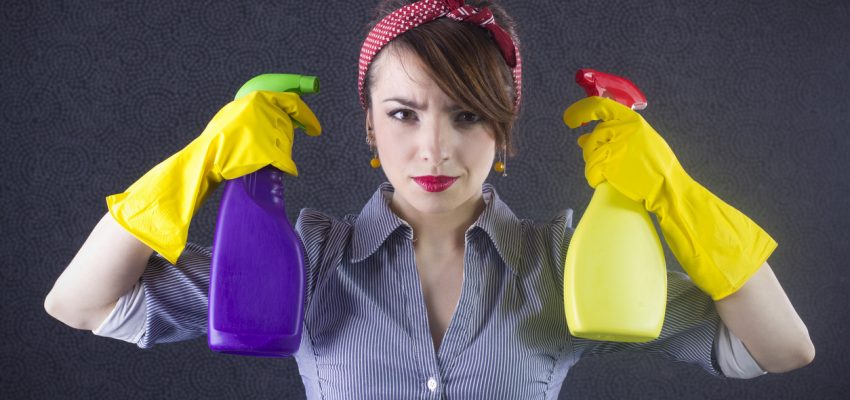We often consider the safety of chemicals used in buildings or homes, but pay little attention to the potential risks of using everyday indoor cleaning products.1,2 While cleaning is supposed to help us get rid of nasty germs and bacteria, studies show exposure to cleaning products over time may produce serious side effects in the respiratory and renal systems.2 We think of cleaning products as safe, but inconsistent labeling and hard-to-pronounce ingredients can make it difficult to really know what’s in these products.
In 1976 Toxic Substances Control Act, thousands of previously untested chemicals were grandfathered in. These were chemicals already in use at the time, but were not tested to the same standards as they are today.3
Only in the past year has the U.S. Environmental Protection Agency put forth a new process that will help evaluate and prioritize the risk of using these chemicals.
As we become more aware of the potentially toxic chemicals in cleaning products, there’s a growing interest in natural, and chemical-free cleaning alternatives.
‘Green cleaning’ focuses on harnessing the properties of natural herbs and products to clean everyday living spaces. Essential oils have been gaining increasing support for their natural antibacterial, disinfecting and germ killing properties.
#1 Lemon Essential Oil
Known for its bright, uplifting smell, you’ll never feel so happy to be cleaning as when using lemon essential oil. Lemon essential oil contains powerful antimicrobial qualities that stop the growth of harmful bacteria, including E. coli.4
#2 Pine Essential Oil
Bring the smell of the great outdoors inside with pine essential oil. With natural antiseptic properties, pine essential oil is used as an ingredient in indoor cleaning products and may help eliminate inhaled pathogens.5 Pine essential oil may also act as a natural respiratory aid for coughing and asthma, which means using it indoors shouldn’t irritate lungs.
#3 Tea Tree Essential Oil
As one of the most versatile essential oils, tea tree essential oil has natural antiseptic, anti-fungal and antibacterial properties that will leave your home smelling great. Use as a part of ‘green’ household cleaner for kitchens, bathrooms and toilets.
Essential oils can be combined with other natural cleaning agents such as vinegar, baking soda or castile soap to enhance results.
Organic Bleach
For a natural bleach alternative, combine 3 Tbsp. of castile soap, 2 cups of water and 25 drops of tea tree essential oil. This natural disinfectant can be used against grime, soap scum or tough to clean places, and is a safer alternative to using bleach in shared areas, such as the bathroom.
Essential Oil Household Cleaner Recipe
To make an easy household cleaner, add 5-8 drops of pine or lemon essential oil to 1 cup of water in a spray bottle. Gently shake the mixture and spray on household surfaces before wiping down with a wet cloth.
Whether you choose to spray, scrub or disinfect, the natural germ-killing properties of essential oils have made it one step easier to green your clean.
References:
- Agency for Toxic Substances and Disease Registry. (n.d.). Health Effects of Chemical Exposure [PDF]. Retrieved June 15, 2017 from https://www.atsdr.cdc.gov/emes/public/docs/Health%20Effects%20of%20Chemical%20Exposure%20FS.pdf
- Nazaroff, W. W., & Weschler, C. J. (2004). Cleaning products and air fresheners: exposure to primary and secondary air pollutants. Atmospheric Environment, 38(18), 2841-2865. https://doi.org/10.1016/j.atmosenv.2004.02.040
- United States Environmental Protection Agency. (2017, January 13). For the First Time in 40 Years EPA to Put in Place a Process to Evaluate Chemicals that May Pose Risk [Press Release]. Retrieved June 15, 2017 from https://www.epa.gov/newsreleases/first-time-40-years-epa-put-place-process-evaluate-chemicals-may-pose-risk
- Prabuseenivasan, S., Jayakumar M., & Ignacimuthu, S. (2006). In vitro antibacterial activity of some plant essential oils. BMC Complementary and Alternative Medicine, 6:39. Retrieved from https://bmccomplementalternmed.biomedcentral.com/articles/10.1186/1472-6882-6-39
- Sadraei, H. (2001). Spasmolytic activity of essential oil and various extracts of Boiss. on ileum contractions. Phytomedicine, 8(5), 370-376. doi:1078/0944-7113-00052
- Carson, C.F., Hammer, K.A., Riley, T.V. (2006). Melaleuca alternifolia (Tea Tree) Oil: A Review of Antimicrobial and Other Medicinal Properties. US National Library of Medicine National Institute of Health, 19(1), 50-62. Retrieved June 15, 2017 from https://www.ncbi.nlm.nih.gov/pmc/articles/PMC1360273/





Amazing article! I use the lemon essential oil all the time! add a pinch to my all natural cleaner and leaves surfaces smelling amazing!
Pingback: How Louis Pasteur Helped Prevent Food Waste